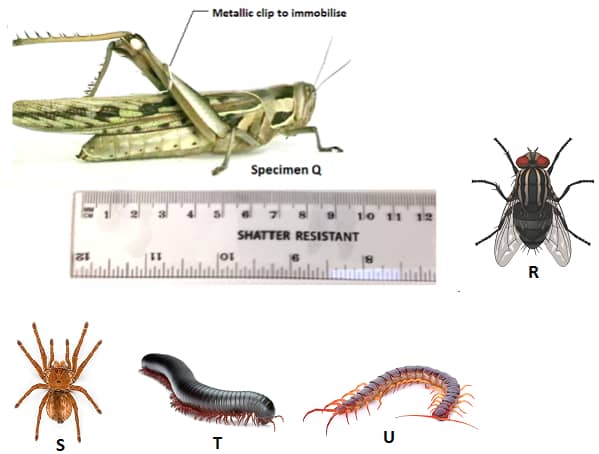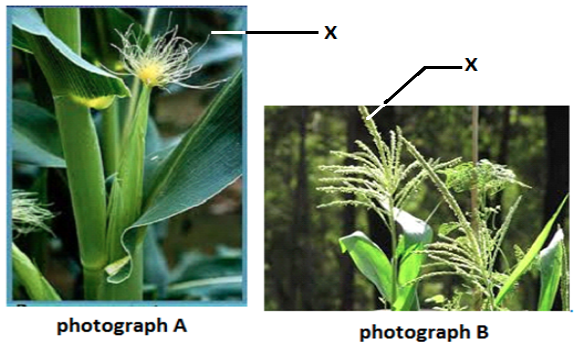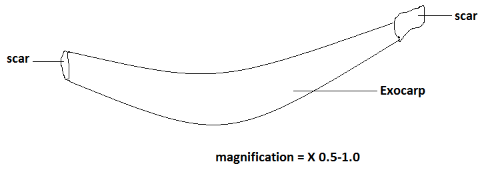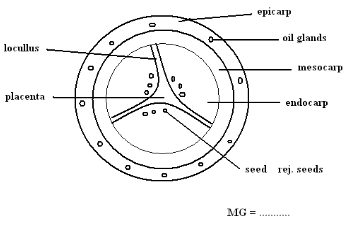Instructions to candidates
- Answer ALL questions in in the spaces provided.
- You are required to spend the first 15 minutes of the 1 ¾ hours reading the whole paper carefully before commencing your work.
- Candidates should answer the questions in English
- You are provided with a specimen labelled Q, use it to answer the questions that follow.
-
- Sketch a drawing and label the specimen on the space provided. (2 marks)
- Make a transverse section of the specimen and label. (3 marks)
- What type of fruit is specimen Q? (1 mark)
- Slice off about 2cm2 cube from the specimen. Peel it. Tie one end of the 8cm LONG transparent visking tubing provided. Place the banana cube and tie the other end to ENSURE THERE IS NO LEAKAGE AND BOTH ENDS OF THE TUBING.
Rinse the outside of the tubing with water. Immerse the tubing with its content in 100ml beaker containing iodine solution. Allow standing for 20 minutes.- Record your observations in the table below. (4 marks)
Contents inside tubing Iodine solution Outside tubing Before the experiment After the experiment - What was the physiological activity under test? (1 mark)
- Account for the results obtained in c (i) above. (3 marks)
- Record your observations in the table below. (4 marks)
-
- You are provided with specimen Q, R S T and U. Study them to answer the questions below.

- Work the actual length of specimen T, given that the shatter resistant ruler measures Q from tip of mouth to tip of abdomen. (3 marks)
- A boy immobilised specimen Q and attempted to drawn and suffocate it in water by placing its head in water. Using observable features, explain why he couldn’t succeed. (2 marks)
- Use the features in order given below and construct a dichotomous key that can be used to identify the specimen above.
Wings, long or short hind limbs, number of legs, antenna. (8 marks) - State three ways in which specimen Q is adapted to evade its predators in its ecological niche. (3 marks)
- You are provided with two photographs below of maize plant (Zea mays) taken from the school farm.Use them to answer the questions that follow.
- Classify the specimen into Division, Sub-division and Class where it belongs. (3 marks)
- Give one reason why you classified it into sub- division above. (1 mark)
- What type of leaf arrangement is shown in photograph A above. (1 mark)
- Giving reasons, give the term used to describe the above flower based on the agent of pollination. (1 mark)
Reasons (2 marks) - On the photographs, label where the pollen grain produced and where stigma is likely to be found respectively. (2 marks)
- With respect to floral arrangement, what term is used to describe maize plant? (1 mark)
CONFIDENTIAL
- Specimen Q Ripe banana
- Iodine Solution
- Visking tubing
- 100ml beaker
- Thread
- Scapel

MARKING SCHEME
- You are provided with a specimen labeled Q, use it to answer the questions that follow.
-
- Sketch a drawing and label the specimen on the space provided. (2 marks)
- Make a transverse section of the specimen and label. (3 marks)
- Sketch a drawing and label the specimen on the space provided. (2 marks)
- What type of fruit is specimen Q? (1 mark)
- Berry;
- Slice off about 2cm2 cube from the specimen. Peel it. Tie one end of the 8cm LONG transparent visking tubing provided. Place the banana cube and tie the other end to ENSURE THERE IS NO LEAKAGE AND BOTH ENDS OF THE TUBING.
Rinse the outside of the tubing with water. Immerse the tubing with its content in 100ml beaker containing iodine solution. Allow standing for 20 minutes.- Record your observations in the table below. (4 marks)
Contents inside tubing Iodine solution Outside tubing Before the experiment Grey Brown After the experiment Blue-black Brown - What was the physiological activity under test? (1 mark)
- Diffusion;
- Account for the results obtained in c (i) above. (3 marks)
- Iodine ions / particles are smaller in size and hence entered into the visking tubing by diffusion/ along concentration Gradient ; through the pores; and reacted with starch solution/ solution Q; While extract molecules/ solution Q cannot come out since they are too large to diffuse out.
- Record your observations in the table below. (4 marks)
-
- You are provided with specimen Q, R S T and U. Study them to answer the questions below.
- Work the actual length of specimen T, given that the shatter resistant ruler measures Q fro tip of mouth to tip of abdomen. (3 marks)
Drawing magnification = Drawing length Of Q Drawing length Of T
Actual length Actual length
= 65 mm = 40mm
85 mm actual length of T
Actual Length of T = 85 × 40
65
= 52.3 mm - A boy immobilised specimen Q and attempted to drawn and suffocate it in water by placing its head in water. Using observable features, explain why he could not succed. (2 marks)
- The abdomen has spiracles; and therefore gaseous exchange continued;
- Use the features in order given below and construct a dichotomous key that can be used to identify the specimen above.
Wings, long or short hind limbs, number of legs, antenna. (8 marks)-
- Animals with wings ................................................................................... go to 2
- Animals without wings ............................................................................. go to 3
-
- Animals long limbs .................................................................................... Q
- Animals without long limbs ...................................................................... R
-
- Animals with more than four pairs of legs ........................................... S
- Animals with more than four pairs of legs ............................................... go to 4
-
- Animals with long Antenna ..................................................................... U
- Animals with short Antenna .................................................................... T
-
- State three ways in which specimen Q is adapted to evade its predators in its ecological niche. (3 marks)
- Brown/ comouflaged to blend with environment; - hindlimbs has spines; - hind limbs are large enabling the organism to jump;
- Work the actual length of specimen T, given that the shatter resistant ruler measures Q fro tip of mouth to tip of abdomen. (3 marks)
- You are provided with two photographs below of maize plant (Zea mays) taken from the school farm. Use them to answer the questions that follow.
- Classify the specimen into Division, Sub-division and Class where it belongs.
- Division (1 mark)
- Spermatophyta;
- Sub-division
- Angiospermaphyta; (1 mark)
- Class
- Monocotyledonae; (1 mark)
- Division (1 mark)
- Give one reason why you classified it into sub- division above. (1 mark)
- Presence of flowers;
- What type of leaf arrangement is shown in photograph A above. (1 mark)
- Alternate;
- Giving reasons, give the term used to describe the above flower based on the agent of pollination.
- Term - Anemophilous flower; (1 mark)
Reasons (2 marks) - anthers/stigma hang outside the flowers to increase chances of pollination; the filament/style is long to expose anthers/stigma;
- Term - Anemophilous flower; (1 mark)
- On the photographs, label where the pollen grain produced and where stigma is likely to be found respectively. (2 marks)
- With respect to floral arrangement, what term is used to describe maize plant? (1 mark)
- Monoecious plant;
- Classify the specimen into Division, Sub-division and Class where it belongs.
Join our whatsapp group for latest updates
Tap Here to Download for 50/-
Get on WhatsApp for 50/-
Download Biology Paper 3 Questions and Answers - Pavement Mock Exams 2021/2022.
Tap Here to Download for 50/-
Get on WhatsApp for 50/-
Why download?
- ✔ To read offline at any time.
- ✔ To Print at your convenience
- ✔ Share Easily with Friends / Students




